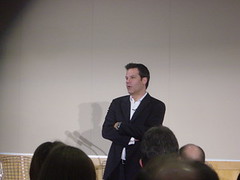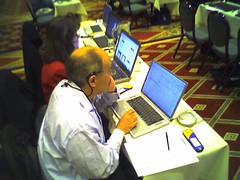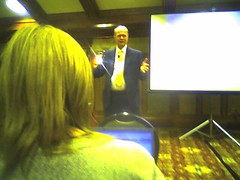 Perhaps more than anything else. Richard Florida is credited for making a compelling case for the connection between economic growth and creativity. Throughout the address, he refered to the Creative Age as a contrast to the Industrial Age.
Perhaps more than anything else. Richard Florida is credited for making a compelling case for the connection between economic growth and creativity. Throughout the address, he refered to the Creative Age as a contrast to the Industrial Age.
He explained in the beginning that he would be talking about creativity and globalization, and not so much about education. I think that it was all about education. He said (and I paraphrase only slightly) that, “The transformation from industrial to creative economy is as big, no bigger, than transformation from agriculture to industry.” He continued, “We innovated enormously during the previous transition. Our challenge to innovate today is even bigger.”
The golden age of America (1950s and 1960s) took over 100 years to establish. We have much less time, now, and it may not see it happen. Florida says that he is optimistic in the long run. For the first time the logic of our economy is known. We know what we must do. We know that we can no longer generate wealth through physical labor and raw materials. We must develop our creative capabilities.
In America 40,000,000 people work in the creative sector. This includes engineers, scientists, artist, entertainers, etc. It’s 150,000,00 world wide. He said that if you take salaries of the three major sectors (manufacturing, service, and creative), the salaries of creative sector are more than the other two combined.
In the next 10 years, we’re going to lose 500,000 manufacturing jobs. Grow 5,000,000 sevice jobs. Grow 10,000,000 creative sector jobs. 400,000 jobs in entertainment. This is all in the next ten years. Not only is this all changing our economy, but it’s also changing how we do things. The way we use our time, structure our day, conduct our leisure, and manage our cities.
Florida stresses that we are not just talking about attracting the creative class. The point is much more basic — the critical thing we must understand. Every single human beeing is creative. A big part of the fix is education, but there are other avenues that we must entertain. We’re losing 65% to 70% of the creative potential of our people.
Toyota realized that the real creative potential was on the plant floor. The creativity that brought Toyota out was the workers. The real source of innovation is in the trenches. (Whoa! Teachers are where the innovation is. How do we tap into that. How do we encourage, value, and share the creativity of the classroom. How about students. How do we tap into the creativity of our students to affect education?)
Creativity knows no boundaries. Sex, color, nationality. It’s universal. This is why, the places that are seeing their economies growing are places that are open and tolerant. In America, we cultivated an environment where creative people wanted to be. So much of our high tech (five of six of the founders of Intel were not born in the U.S., the founder of Amazon, and many more. I need to get that list)
In the U.S. we have three deficits. Budget and trade are the ones we talk about. But the one that we need to really worry about is our knowledge deficit. 30% to 40% of our computer science depends on immigrants. Yet we are restricting immigration at a crtical time. In New Zealand (home of Peter Jackson’s moving making facilities), immigration is run by the technology department.
The common theory of globalization suggests that due to the knowledge revolution, the world is becoming more level — flat (The World is Flat, Thomas Friedman). This is half right. Technology and communication have allowed the world to become flat. But there are always two sides. Economic activity is also re-concentrating into fewer and fewer places around the world. Creative people must cluster together in order to be productive. Cities are growing bigger and bigger and bigger. There are about a dozen (i.e., Shanghai, Bangalore). The world is not flat, but spikey. Florida says that we are in one of the innovative centers, here in the Research Triangle. In addition, the world is not only becoming more oriented around cities but the cities are becoming disconnected from their countries.
Florida then talked a bit about what makes people happy (i.e. how do you attract the creative class). He said that when asked, most people say that it is family and friends that make them happy. Many say that its their work experience and challenge. Rarely do they say that it’s the place that they live. However, a recent Gallop poll indicated that where we live has much more to do with our happiness than we think. What is important about the place we live are safety, education, government, and leadership. But these are the basics. They found that there are two prevailing aspects of where you live that run across all demographics. Number one is the aesthetics of the place. How it looks. And the second is our ability to express ourselves. Both were higher than all other aspects.
Jim Goodnight, CEO of SAS, and June Atkinson, State Superintendent of Schools, joined Richard Florida for a panel discussion, and they opened things up for a few questions from the audience. I did not take notes during this part of the session, because it was very difficult to hear both Goodnight and Atkinson. But here are some of the themes that came out.
Richard Florida admittedly played the part of the provocateur. He suggested, without advocating, home schooling. He also said, “We have to get rid of the bells. We have to get rid of the idea that the cell phone is the enemy. The classroom should look more like a studio.”
The importance of attracting more children into the fields of science, mathematics, and technology were also discussed, as well as the need to modernize classrooms with appropriate technologies. Goodnight talked a bit about their Cary Academy, a high-tech prep school built by SAS. I need to make another visit there some time soon.
Richard Florida does not like testing. He said so several times, and seemed pretty passionate about it. He described himself as a dropout who stayed in school, but focused his efforts on playing in rock bands rather than study. He dropped back in during college. How many of us could characterize ourselves similarly?
June Atkinson defended North Carolina’s current direction adequately, saying the right things from my perspective. I would like to have seen a more forceful expression of some outside the box ideas, but I suppose she is not in a position to do that. She did talk about a different kind of teaching, a different kind of learning, and classrooms where students are becoming creative inventors (my words) at the same time they are becoming more knowledgeable. I want to see what that looks like. We need a story.
Another theme that generated a lot of discussion was the appalling dropout rate. At least they’re telling the truth now and not cooking the numbers. Public education in North Carolina is losing between 35% and 40% of its students from the time they begin their freshman year and graduation. Some one in the audience suggested that the not allow students to drop out of school until they reach 18. That’s not the problem. It’s the school that are not serving the needs of today’s kids, that’s the problem. But that’s just my opinion.
Near the end of the event, when they said that they would take one more question, I enthusiastically raised my hand, wanting to ask about the teacher dropout rate, the crisis we (in North Carolina) are facing as we need 10,000 new teachers every year and are graduating only 3,500 from all of our schools of education. I was also going to suggest that we try to envision a teacher who are empowered to be creative and creatively empowered students. I yielded, however, to Bill McNeal, the Wake County Superintendent, who made a passionate plea for the resources to restructure teaching and learning in North Carolina.
In closing, I do not remember who said this, but it rings very true to me.
The worse thing a student can say about homework is that it’s too hard. The worse thing they can say about a video game is that it’s too easy.
I’ll have to use that one 😉


 Here are some high-points from Dave Sifry’s February
Here are some high-points from Dave Sifry’s February 



